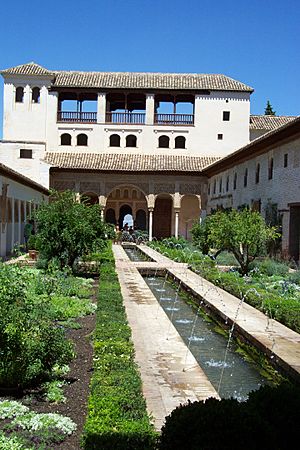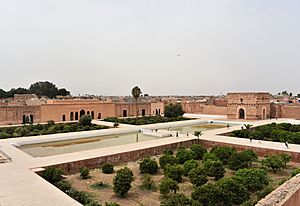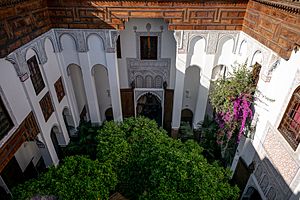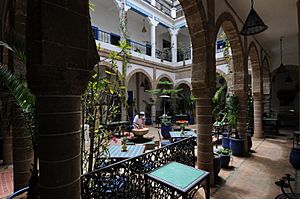Riad (architecture) facts for kids
A riad (pronounced "ree-ad") is a special kind of traditional house or palace from Morocco and Al-Andalus (an old Muslim region in Spain). It has an inside garden or courtyard at its center. People think this style came from Persian gardens a long time ago, spreading during the Islamic period.
Today, in Morocco, the word "riad" often means a hotel or guesthouse. These places usually have shared areas and private rooms. They are often found inside old, restored traditional mansions.
Contents
History of Riads

The word riad comes from the Arabic word "رياض" (riyad), which means "garden." In the past, it described a specific type of inner garden. This garden was common in old Moorish architecture in Spain (Al-Andalus) and North Africa.
A classic riad garden is usually rectangular. It is divided into four equal parts by paths that cross in the middle. Often, there is a fountain right in the center.
Ancient Roots of Riad Design
The idea of houses built around inner courtyards is very old. It started in ancient Mediterranean and Middle Eastern cultures. Before that, similar designs were found in the Ancient Near East.
Gardens inside homes are also an old feature in the Middle East. The beautiful, geometric gardens of Islamic architecture were especially inspired by Iranian civilization. Old garden remains have been found in Mesopotamia. Later, these designs led to the grand, planned gardens of Iranian and Mughal architecture, called a chahar bagh.
How Riads Spread
After the 7th century, the Islamic world grew. This helped spread these building styles across the region. They even reached al-Andalus in Spain. Inner gardens were popular in Islamic palaces. This is because water and green plants reminded people of paradise in Islam.
Experts believe that riad gardens in the western Islamic world came from Persian gardens in the east. The ancient Roman city of Volubilis in Morocco also influenced early Moroccan house designs.
Famous Early Riads
Important examples of riad-like gardens in al-Andalus include:
- Madinat al-Zahra (from the 900s)
- The Aljaferia (from the 1000s)
- The Alhambra (from the 1200s-1400s)
It's not fully clear if Moroccan riads were directly inspired by designs from al-Andalus. They might have developed on their own at the same time. However, Morocco and al-Andalus had strong cultural ties.
Moroccan Riad Development
When the Almoravids (from Morocco) took over al-Andalus in the 1000s, they hired artists from Spain. These artists, who were Muslim, Christian, and Jewish, worked on buildings in Morocco. This helped create a shared art style.
The first known true riad garden in Morocco was found in a palace built by Ali ibn Yusuf in Marrakesh in the early 1100s. This was during the Almoravid rule. The time of the Almoravids and later dynasties (like the Almohads and Marinids) was key. During this period, the riad garden became a standard part of palace architecture in the region.
Riads were very successful in Marrakesh. The city's climate and space were perfect for them. They became common in the homes of wealthy people and in royal palaces.

Later Moroccan royal palaces also featured riad gardens. The famous El Badi in Marrakesh, built in the late 1500s, was a huge riad courtyard. It had gardens, pools, and two large buildings facing each other.
The biggest riad garden in Marrakesh today is the Arsat an-Nil. It is located in the Royal Palace. This garden is very large, about 130 meters long and 70 meters wide. It has paths that divide it, making it a giant version of a riad.
Riads became more common in Fes only in recent centuries. The city's existing buildings and sloped land made it harder to build large gardens there. The Dar Batha palace (now a museum) in Fes, built in the late 1800s, is a clear example of a classic riad.
Moroccan Home Design

The riad is one of the two main types of traditional Moroccan houses. It often has two or more floors built around a central, symmetrical garden with a fountain. Riads were the grand city homes of the richest people, like merchants and royal officials. These wealthy citizens could afford to build mansions with inner gardens.
Privacy and Protection
Moroccan houses were designed to be private. They faced inward, protecting families from outside views and the weather. This inward focus meant a central inner garden or courtyard. The outside walls, made of rammed earth or mud brick, had few large windows.
This design also fit with Islamic society's values. Privacy was very important. It kept private family areas (where women often lived and worked) separate from semi-public spaces for guests.
Garden Features and Decorations
The central gardens of traditional riads often had fruit trees. Orange trees or lemon trees were common. The walls of the riads were beautifully decorated. They might have smooth tadelakt plaster, fancy stucco designs, and colorful zellij tiles. Sometimes, these decorations included Arabic calligraphy and quotes from the Quran.
Riads and Tourism

In recent years, many people have become interested in using traditional Moroccan houses for tourism. Because of this, the word riad is now often used for any traditional Moroccan house. It especially refers to those that have been turned into places for tourists to stay.
This interest has led to many old houses being fixed up. In cities like Marrakesh, Essaouira, and Fes, many crumbling riads have been restored. They are now hotels, guesthouses, or restaurants. Many ruined properties in Marrakesh have been bought by people from other countries. This foreign interest has brought new challenges, but it has also helped a lot. It has supported the restoration of these historic sites. It has also helped bring back many traditional crafts and artisan jobs that were slowly disappearing.
See also
 In Spanish: Riad (arquitectura) para niños
In Spanish: Riad (arquitectura) para niños
- Andalusian patio
- Courtyard house


